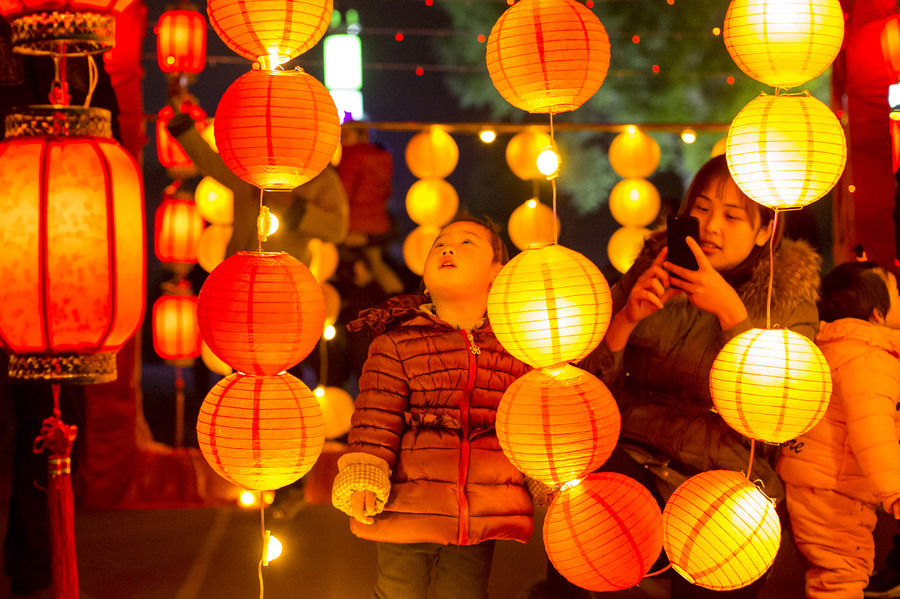

As a result, he ordered all households, temples and the imperial palace to light lanterns on that evening. Emperor Ming, an advocate of Buddhism, noticed Buddhist monks would light lanterns in temples on the fifteenth day of the first lunar month. However, its roots trace back more than 2,000 years and is popularly linked to the reign of Emperor Wen of the Han dynasty. There are several beliefs about the origin of the Lantern Festival. In London, the Magical Lantern Festival is held annually. Lantern Festivals have also become popular in Western countries, such as the Water Lantern Festival held in multiple locations in the United States. It should not be confused with the Mid-Autumn Festival which is sometimes also known as the "Lantern Festival" in locations such as Indonesia, Malaysia, and Singapore. The festival acts as an Uposatha day on the Chinese calendar. The lanterns are almost always red to symbolize good fortune. The lanterns can symbolize the people letting go of their past selves and getting new ones, which they will let go of the next year.

For example, lanterns are now often made in the shape of animals. In modern times, lanterns have been embellished with many complex designs. In ancient times, the lanterns were fairly simple, and only the emperor and noblemen had large ornate ones. ĭuring the Lantern Festival, children go out at night carrying paper lanterns and solve riddles on the lanterns ( traditional Chinese: 猜燈謎 simplified Chinese: 猜灯谜 pinyin: cāidēngmí). As early as the Western Han Dynasty (206 BC–AD 25), it had become a festival with great significance. Usually falling in February or early March on the Gregorian calendar, it marks the final day of the traditional Chinese New Year celebrations.
CHINESE LANTERN FESTIVAL LOS ANGELES FULL
The Lantern Festival ( traditional Chinese: 元宵節 simplified Chinese: 元宵节 pinyin: Yuánxiāo jié), also called Shangyuan Festival ( traditional Chinese: 上元節 simplified Chinese: 上元节 pinyin: Shàngyuán jié), is a Chinese traditional festival celebrated on the fifteenth day of the first month in the lunisolar Chinese calendar, during the full moon. Statues of mother and daughter celebrating the Lantern Festival. Magha Puja (in Thailand, Sri Lanka, Myanmar, Cambodia and Laos) Yuánxiāo jié ( 元宵節) / Shàngyuán jié ( 上元節)Ĭhotrul Duchen (in Tibet Province of China) I am sad, with tears shed on the sleeves of my spring coat.Lantern Festival celebrated in Tainan at night This year the moon and lanterns are still the same, yet you are not here anymore. We met after dusk when the moon rose behind willow trees. It goes like this: "Last lantern festival, the flowers fair, decorated with lights were daylight bright. Ouyang Xiu, a famous poet from the Song Dynasty, depicted a woman's longing for the man she met during Lantern Festival in his poem Yuan Xi. Romance often happened, although not all of these stories ended happily. On the night of that day, unmarried men and women would meet at the flower fair and lantern-decorated street. Lantern Festival is one of the festivals that provided ancient Chinese single young men and women a chance to meet and get to know each other. Ancient Chinese had milder ways to encourage people to find a spouse, such as fairs and meetings during festivals. However extreme policies to force people to get married were rare, and young people still had certain freedoms to get married with people they liked, rather than being completely manipulated by their parents or government. If a female was still single at 17, there would be a forced marriage with local administrators' involvement.

Single women had to get married by a certain age. During some periods, like the Jin Dynasty (265-420), marriage policies went to extremes. In ancient China, marriage was often decided by parents or even the government. It has been an important festival since the Western Han Dynasty (206BC-AD 24). Lantern Festival, which was celebrated on Saturday this year, marked the final day of the Chinese Lunar New Year.
CHINESE LANTERN FESTIVAL LOS ANGELES SERIES
Two shots from the 2000 TV series Da Ming Gong Ci, featuring Princess Taiping's first accidental meeting with her future husband Xue Shao on the night of Lantern Festival in the Tang Dynasty.


 0 kommentar(er)
0 kommentar(er)
